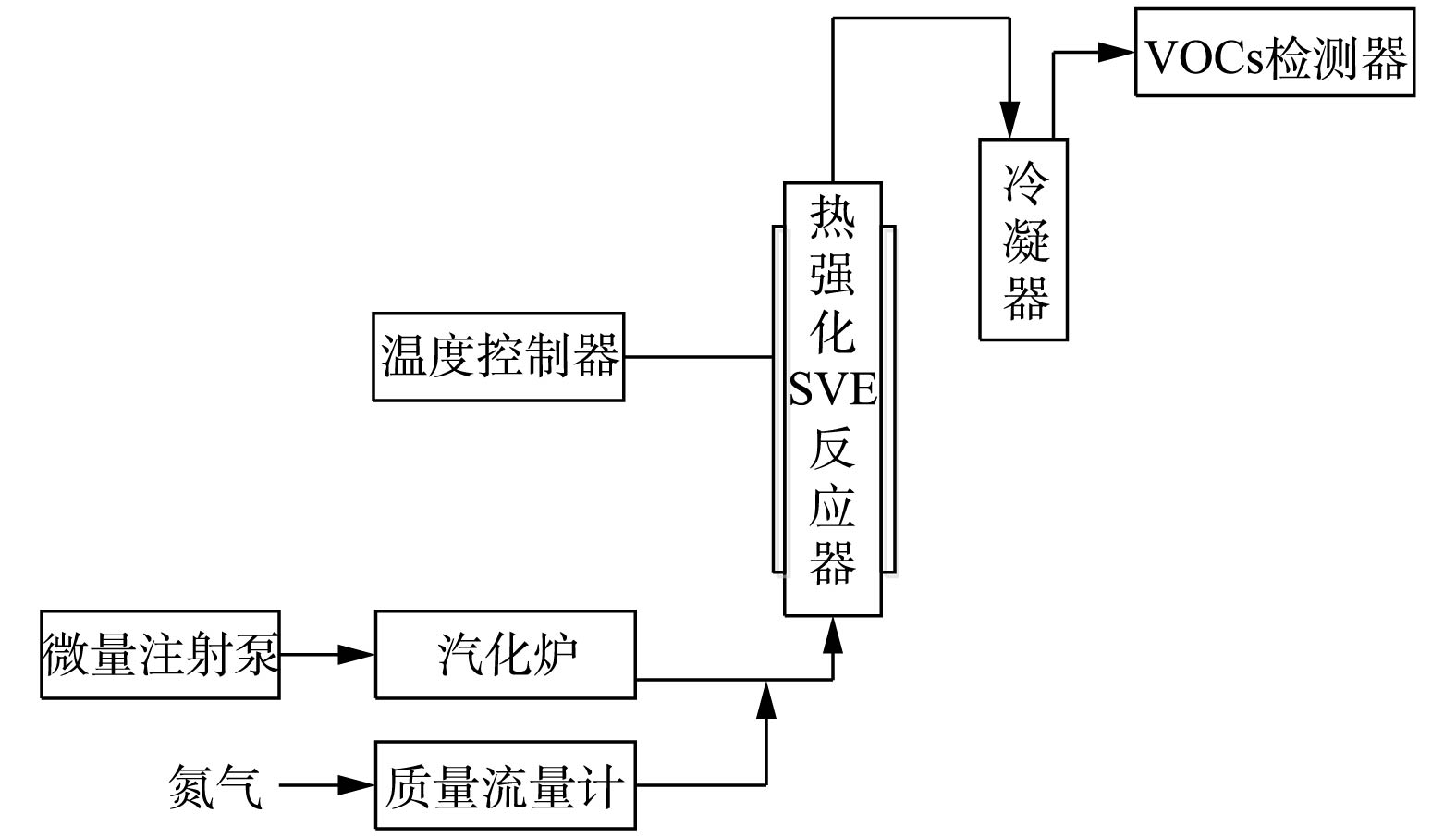-
我国土壤污染已对土地资源可持续利用与农产品生态安全构成威胁,因油田开采造成的严重石油烃类污染土地面积达1×108 m2,石油炼化业也使大量土地受到污染[1]。石油相关产业的废物管理不善,会对地表径流产生二次污染,影响废水灌溉和大气沉降,同时对人类健康构成风险[2-5]。石油类污染物在进入土壤后,除了造成环境污染,还会改变土壤理化性质,破坏土壤本底结构,影响土壤通透性,对周边生态环境造成严重的威胁[6-7]。其中有机污染物的降解是一个较为复杂的过程,特别是那些不易挥发、高沸点的有机物[8-9]。最常见的烃类土壤修复方法包括原位热脱附技术、异位热脱附技术、生物修复和土壤蒸汽提取(SVE)。其中原位热修复热脱附效率高、可灵活运用,便于土壤污染处理的工程操作和使用[10]。异位热脱附技术具有污染物去除率高、修复周期短、普适性强等显著优势[11]。生物修复成本低,但是周期长,可能需要数年才能完成。土壤蒸汽提取是利用真空泵产生负压,驱使空气流经污染土壤的孔隙,解吸并携带挥发性和半挥发性污染物,从抽气井排出[12]。热强化技术是一种烃类污染土壤修复的重要手段[13],在运行过程中,土壤温度、循环水温度、土壤湿度和污染物浓度等都会影响修复效率[14]。
现有烃类污染土壤修复的研究主要侧重于影响因素的对比[15-19],少有结合参数优化系统开展热强化脱附动力学的研究。卢中华等[19]发现,在通风条件下,土壤中有机污染物四氯化碳的去除过程符合一级反应动力学,增大通风速率能提高土壤中有机污染物四氯化碳的去除率。YANG等[20]研究了挥发性有机污染物甲苯在不同孔隙结构土壤中的吸附和脱附行为及动力学,结果表明,影响甲苯脱附速率的主要因素是污染土壤中的孔隙结构和体积。于颖等[18]对热强化气相抽提法修复半挥发性石油烃污染土壤的影响因素进行了深入研究,并用热脱附动力学来描述土壤中的有机物的去除过程,实验证明,温度决定性地影响了石油烃污染土壤的修复效率,污染土壤残留率与加热温度基本呈反比,石油烃类土壤中的有机物去除过程符合Elovich和Freundlich热脱附动力学方程。王中婵[21]研究了烃类污染土壤中不同孔隙结构对有机污染物脱附动力学特性的影响,实验发现烃类污染土壤孔隙结构越复杂,VOCs脱附时间越短且脱附越完全。
本研究探讨了通气速率、抽提气中的水蒸气浓度以及含水量等因素对烃类污染土壤热脱附净化效率的影响机制,通过高斯(Gauss)模型拟合抽提气中碳氢化合物(hydrocarbon,HC)浓度和热强化SVE处理时间的函数关系,运用LDF和Freundlich方程对脱附过程进行了拟合,计算动力学参数,并研究了脱附动力学的适用范围,所得参数优化和热强化脱附动力学的结果可为开展热强化SVE处理烃类污染土壤研究提供参考。
全文HTML
-
选取未被污染的弱碱性、沙土型的潮土,去除杂物烘干,筛分6~10目,与汽油混合均匀并密封放置2 d,制备HC总浓度为14 000 mg·kg−1的模拟污染土壤。根据实验要求,在未污染土壤中加入不同体积的水分和汽油液体。土壤含油率的测定采用CCl4萃取法,通过总油脂/总石油烃红外分析仪测量。
-
如图1所示,热强化SVE实验装置由汽化炉、温度控制器、热强化SVE反应器和VOCs检测器等组成。整个过程发生的机理是,通过在土壤中形成负压来抽提加热产生的污染气体[10]。由于土壤脱附气中含有一定浓度的HC组分,从安全角度考虑,选用惰性的氮气作为吹扫气体。
使用聚光GC-3000-115在线气相色谱分析仪连续测量抽提出气中VOCs的浓度,以气体中HC浓度降到800 mg·m−3时对应的时间texp为评价参数。气相色谱检测条件:FID火焰温度≥130 ℃、阀箱温度175 ℃、柱箱温度80 ℃、总压400 kPa左右、样气压力101 kPa左右。
在土量为80 mL的实验条件下,首先研究了通气速率(40、60、80和100 mL·min−1)对热强化SVE处理过程的影响,发现抽提气体流量为80 mL·min−1时,土壤中有机污染物的脱附效率最高。因此,在研究抽提气中水蒸气浓度(0%、5%、15%、25%)和土壤含水量(0%、5%、10%、15%)对土壤中有机污染物的脱除效率影响时,选用80 mL·min−1的抽提气体流量。通常,在复合污染条件下,温度使得各污染物有效态降低[22]。为避免水蒸气遇冷液化影响实验效果,所有实验的加热温度均为120 ℃。
-
本研究采用Gauss模型,拟合抽提气中HC浓度C和热强化SVE处理时间t的函数关系,拟合方法[23]如式(1)所示。
式中:Cg为处理后抽提气中HC的浓度,mg·m−3;Cg0为原始状态下HC的浓度,mg·m−3;t为脱附时间,min;tc为抽提气中HC浓度达到最大值的脱附时间,min;A和w为脱附动力学常数,min−1。
当t=tc时,浓度达到最大值Cg,max。
式中:Cg,max为抽提气中HC浓度的最大值,mg·m−3;C0为初始浓度,mg·m−3。
本研究侧重于Cg,max数值的计算,并以Cg,max的值作为重要的评价标准。
脱附动力学是研究气态污染物分子在土壤中扩散行为的重要手段。在120 ℃的处理条件下,烃类组分热分解可能性很小,可用线性驱动力(LDF)模型来计算土壤中有机污染物的脱附动力学,该模型经常用来描述一系列气体/蒸气在炭吸附材料(活性炭、炭分子筛和硅胶)的吸附动力学[24],计算方法如式(3)所示。
式中:η为相对去除率;Mt为在时间t的脱附量,mg;Me为平衡脱附量,mg;k为脱附动力学常数,min−1。
采用Freundlich动力学方程分析一系列反应机制的过程,主要用于描述吸附能随表面饱和度的增加呈指数衰减的过程,计算方法[14]如式(4)所示。
式中:C为土壤中有机物的浓度,mg·m−3;A和B为脱附动力学常数,min−1。
1.1. 模拟土样制备
1.2. 热强化SVE处理实验
1.3. 脱附过程动力学研究
-
抽提气体流量对烃类污染土壤处理的影响见图2和表1。图2(a)为脱附时间与脱附气体中HC浓度的实验拟合结果,本研究将图2(a)中抽提气体浓度和时间的曲线进行积分处理,得到脱附量Mt和Me值。根据总石油烃红外分析仪所得处理后的土壤中总烃的浓度Cs,计算热脱附的实际净化效率ηexp;根据LDF模型,计算热强化SVE处理的理论所需时间tsim。结果见表1和图2(b),Freundlich方程拟合结果见图2(c)。
由图2(a)可知,抽提尾气中HC浓度随时间的变化曲线呈基本对称的抛物线,但土壤中烃类组分的去除过程经过先快速、后慢速2个阶段,在热脱附的后期,出现拖尾的现象。这是因为土壤细粒表面存在自由能,烃类组分可被其表面吸附[25-26]。气体抽提造成土壤下层吸附的有机物组分被吹扫脱附,随气流流动并扩散到土壤上层,由于表面自由能和分子间作用力等综合作用,土壤上层再次吸附烃类组分,造成土壤中的VOCs浓度相比于下层较高[14],且在土壤颗粒内部吸附的烃类组分脱附速率较慢,因此,污染物浓度呈现随着脱附时间的延长,先增大,后减小,最后出现拖尾的趋势。此外,在40 mL·min−1的实验条件下,土壤处理后残留的烃类浓度VOCs最高,为948 mg·kg−1,对比生态环境部2018年8月1日开始实施的《土壤环境质量建设用地土壤污染风险管控标准(试行)》[27],虽然没有总烃的限值,但其中挥发性有机物甲苯的筛选值和管制值均为1 200 mg·kg−1。因此,本研究重点以修复时间为评价值,当脱附气中HC浓度降低到800 mg·m−3时,结束实验,所用的时间即为SVE热修复所需时间。
图2(b)是脱附处理时间和土壤中有机污染物去除率的关系曲线。在不同实验条件下,土壤中有机物浓度的变化趋势基本一致,经过400 min处理后,土壤中有机物去除率均超过95%。随着抽提气体流量的增大,脱附的气态烃类组分外扩散阻力减小,传质速率加快。当抽提气体流速在80 mL·min−1和100 mL·min−1时,在热强化脱附处理过程的前期,土壤中有机污染物的脱除速率高于其他气体流速条件下的结果。脱附曲线用LDF方程拟合后的结果见表1,计算所得动力学常数k由0.006 35增大至0.008 82,且流量大于80 mL·min−1后,k基本稳定,这与马艳飞等[25]使用动力学方程拟合土壤中污染物的去除过程所得的结论一致。同时,当流量从40 mL·min−1提升至100 mL·min−1时,处理时间texp由425 min缩短至330 min,抽提气中HC浓度峰值从7 785.50 mg·m−3增大到28 840.87 mg·m−3。实验所需时间texp与LDF模拟拟合计算所需时间tsim1基本一致,由此可以看出,在抽提气体流量单一因素影响条件下,土壤中有机污染物的去除过程符合LDF动力学方程模型。
由表1可知,Freundlich方程拟合计算所得tsim2与LDF拟合计算的结果相比,偏差略大,这与Freundlich方程更适合于拟合多因素反应过程相关。同时,在40 mL·min−1和60 mL·min−1实验条件下,偏差率分别为20%和9.7%,这与脱附处理初期脱附速率较慢有关。这主要是由于污染物总量相同,单个土壤粒子所含的平均污染物浓度相对较低,污染物在土壤中的迁移转化过程较慢,故脱附速率比较缓慢[16]。
此外,通气速率越大,气体吹扫越快,部分土壤粒子被吹扫迁移,被气体夹带向出气口方向移动,对土壤的修复起干扰作用[28]。在80 mL·min−1和100 mL·min−1处理条件下,动力学常数k基本一致。因此,在研究其他因素对土壤中有机污染物的脱除效率影响时,选用80 mL·min−1的抽提气体流量。
-
水蒸气浓度GWC对烃类污染土壤处理的影响见图3和表2。当抽提气体中没有水蒸气时,烃类组分吸附于土壤颗粒上,导致自身逸度值不高,影响其在土壤孔隙空气中的整体挥发速率,烃类污染物去除速率相对较低。在抽提气体中增加水蒸气后,脱除效率明显提高,当GWC为15%时,处理时间从350 min缩短到105 min,且脱附气体中HC浓度峰值从24 568.87 mg·m−3增加到140 235.08 mg·m−3时,动力常数k值为0.036 83,是没有水蒸气条件下k值的4.2倍。这是因为水分子的极性强于烃类组分,与土壤颗粒表面组分更易结合,增加GWC,吸附态烃类组分更易释放出来,且根据相平衡理论,部分污染物会进入到水蒸气中,随气体被带出土壤,有机污染物的去除速率加快[18]。当GWC继续增加到25%时,脱除速率减慢,处理时间延长到240 min,水蒸气组分会占据土壤的孔道空隙,减小土壤中气体流动通道体积,降低土壤的通透性,反而增加了有机污染物的脱附时间[15]。因此,针对烃类污染土壤中有机污染物的去除率,存在一个相对合理的水蒸气浓度GWC含量区间。
LDF一级动力学方程是描述扩散机制控制的动力学过程,涉及的主要机制单一且能量变化不大,不适合描述颗粒表面和液体膜内的扩散。因此,在抽提气中含有水蒸气的条件下,LDF方程拟合所得的结果与实验结果偏差较大。当水蒸气浓度GWC提高到15%时,实验时间和拟合计算所得时间的偏差绝对值达到13.3%。由于Freundlich方程适用于多因素影响过程的拟合,当抽提气中有水蒸气时,水分会因汽化蒸发而存在对污染物的“汽提”作用[29],与有机污染组分之间距离减小,水蒸气与有机污染组分之间存在相互作用。从Freundlich方程拟合结果可见,当水蒸气浓度GWC为15%时,拟合计算所需时间tsim1与实际时间texp基本一致,相对偏差绝对值为3.8%,拟合度更高。
-
土壤含水量SWC对烃类污染土壤处理的影响见图4和表3。土壤水分对土壤热化学性质影响明显[22]。SWC影响有机物在土壤中的挥发速率、有效孔隙率和透气率,从而影响原位热脱附效果[30]。当SWC增加到5%时,处理时间从350 min缩短到195 min。继续增加SWC到10%时,脱附气体中HC浓度峰值从24 568.87 mg·m−3剧增到114 497.59 mg·m−3,峰值出现时间是35 min,比SWC为5%时提前了48 min,动力常数k值(k=0.018 49)是没有水分条件下k值的2.1倍,此时脱除性能最好;但是,土壤的孔隙间形成水膜,膜阻力会影响HC组分的进一步脱除,尤其是在处理的后期,土壤中有机物的浓度降低,浓度差推动力降低,脱附阻力增加,因此,在SWC高于10%以后,会出现明显拖尾的现象,导致处理时间从195 min增加到290 min。当SWC达到15%时,浓度峰值出现时间增加到130 min,处理时间延长到390 min,净化效率降低。
贺晓珍等[31]认为,土壤含水量是影响SVE修复效果的一个重要因素。本研究结果表明,SWC存在最佳值,这是由于SWC小幅度增加有利于热量的散出,促进挥发过程,从而可以使更多的有机污染物从土壤中蒸发出来,在湿润的土壤中,污染物更容易从土壤表面上脱附出来。由于水分子是极性分子,与非极性的分子相比,更容易和土壤中的有机组分结合,因此,增加土壤含水量能扩展更多的空间去除有机污染物[32]。但从另外一个方面来看,增加土壤含水量会降低土壤的通透性,因此,含水量继续增加,会降低有机污染物的去除效果[33]。从图4中可知,在本研究的条件下,从脱除速率上来看,SWC为10%时达到了最佳的去除效果。
根据LDF一级动力学方程和Freundlich方程拟合的结果,SWC从10%增加到15%时,LDF的拟合度从0.984 9降至0.850 5,偏差绝对值从17.2%增加至18.5%;对比Freundlich的拟合结果,SWC为15%时,偏差率绝对值仅为6.7%,且拟合度也高于LDF方程。由此可见,在有水分的条件下,烃类污染土壤中有机污染物的去除结果更符合Freundlich方程模型。
2.1. 抽提气体流量对模拟污染土壤处理时间的影响
2.2. 水蒸气浓度对模拟污染土壤处理时间的影响
2.3. 土壤含水量对模拟污染土壤处理时间的影响
-
1)当通气速率超过80 mL·min−1时,碳氢化合物的去除率基本趋于平衡,在土壤中含水以及抽提气中含有水蒸气的条件下,去除率存在最佳值,抽提气中水蒸气浓度为15%,去除率是97.9%,土壤含水量为10%时,脱除效率达到99.5%,有利于烃类污染土壤中有机污染物的去除。
2)在抽提气体中没有水蒸气和污染土壤不含水的条件下,LDF动力学方程拟合更适用。因此,方程适合单组分的动力学过程的研究。与实验数据相比较,LDF拟合的偏差均值是1.99%,拟合度比Freundlich动力学方程更高。
3) Freundlich动力学方程适合多组分影响过程的拟合。在研究抽提气中的水蒸气浓度和土壤含水量影响时,拟合结果的偏差绝对值均低于LDF动力学方程拟合的结果,这能够较好地还原烃类有机污染物颗粒表面和液体膜内的扩散过程,在改变抽提气中的水蒸气浓度和污染土壤中的含水量等参数时,拟合效果比较理想。




 下载:
下载:




